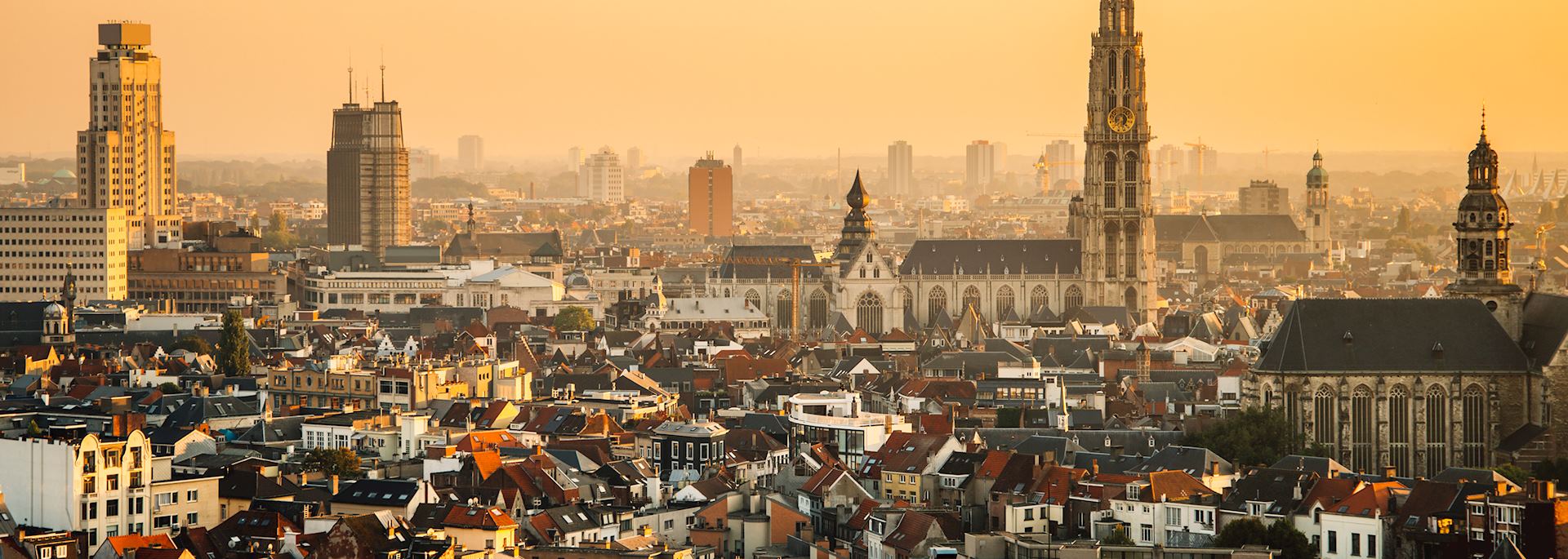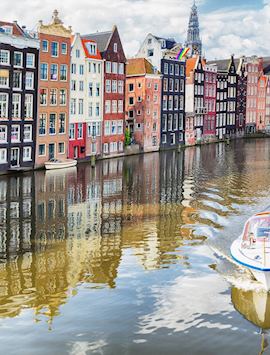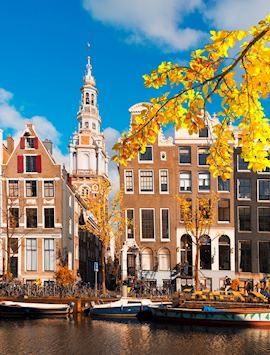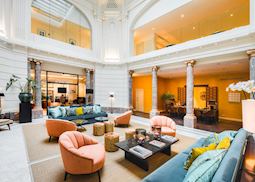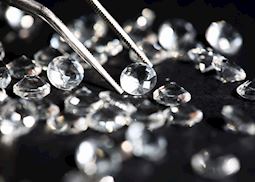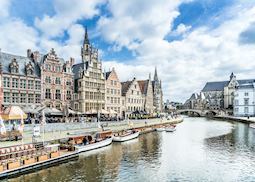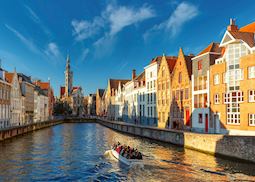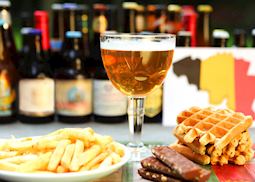Jump to:
Rubens, diamonds, a thriving port and 16th-century architectural glory, all in Belgium’s second city, Antwerp
Blending historic charm, a modern downtown and one of Europe’s biggest ports, Antwerp is Belgium’s second-largest city, yet is often overlooked by visitors. With a legacy of artists like Peter Paul Rubens, a wealth of 16th-century architecture and a world-renowned diamond industry, this city sparkles in more ways than one.
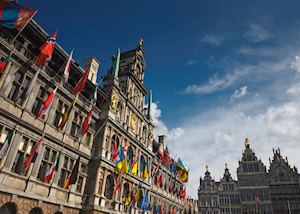 During its peak in the 16th century, the city was responsible for 40% of the world’s trading. Much of its architecture reflects the wealth generated at this time, with ornately designed churches, cathedrals and guild houses dotted across the historic district. The city’s position on the Scheldt River also attracted artists, with Rubens, Van Dyck and Jordaens all living here during their careers.
During its peak in the 16th century, the city was responsible for 40% of the world’s trading. Much of its architecture reflects the wealth generated at this time, with ornately designed churches, cathedrals and guild houses dotted across the historic district. The city’s position on the Scheldt River also attracted artists, with Rubens, Van Dyck and Jordaens all living here during their careers.
You can take walking tours while tasting some of Belgium’s signature dishes, visit dozens of museums and enjoy boat rides on the Scheldt River. We can also arrange day trips to World War II memorial Fort Breendonk, or bike rides along the heritage railway at Sint-Amands.
Things to see and do in Antwerp
Grote Markt
Grote Markt, or Market Square, is the central point of Antwerp’s historic district. The cobblestone plaza is surrounded by 16th-century guildhalls with their characteristic step-gabled roofs, most now housing shops, restaurants and cafés. The Renaissance city hall building predominates, its tall tower decorated with gilded coats of arms and three statues depicting Prudence, Justice and the Virgin Mary.
In front of the city hall, you’ll see a statue depicting a legend that folklore states is the origin of Antwerp’s name. It includes a warrior named Brabo holding a large severed hand aloft, having turned the tables on the toll-taking giant of the Scheldt River, who’d cut off the hands of those who refused to pay and throw them in the river. The Dutch word ‘handwerpen’, meaning ‘hand throwing’, morphed into the city’s Dutch name: Antwerpen.
Cathedral of Our Lady
Just south of Grote Market, you’ll find the monumental Cathedral of Our Lady. The largest cathedral in the Low Countries, its construction was halted in 1521 and has never been finished. Its uneven towers, originally intended to be of equal height, make the Gothic sandstone church one of the more distinctive in Europe. The single spire has such a detailed, delicate construction that Charles V commented it should be kept under glass.
The cathedral’s also known for its altarpieces, painted by native son Peter Paul Rubens, whose triptychs The Raising of the Cross and Descent from the Cross were taken by Napoleon but returned to the cathedral in the 19th century. A third painting, Assumption of the Virgin Mary, serves as the high altarpiece, and you can admire numerous other artworks, including sculptures and stained glass, which adorn the soaring white interior.
Antwerpen-Centraal
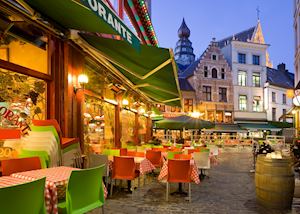 You might not expect a train station to be a city highlight, but Antwerpen-Centraal is widely regarded as the finest example of railway architecture in Europe. You’ll see a mix of styles, from an Art Nouveau façade to Roman columns to a contemporary steel-and-glass dome.
You might not expect a train station to be a city highlight, but Antwerpen-Centraal is widely regarded as the finest example of railway architecture in Europe. You’ll see a mix of styles, from an Art Nouveau façade to Roman columns to a contemporary steel-and-glass dome.
Built between 1895 and 1905, the station’s gray-stone and white-marble entry hall boasts enormous arches, iron-laced half-moon windows and gilded ornamentation. Through one of the gates, the old structure connects directly to the massive, intricate latticed-steel dome that arcs over the train platforms, where you might embark to numerous other European destinations.
Rubenshuis
The former home of the Belgian artist Peter Paul Rubens, the Rubenshuis or Rubens House has been converted to a museum where you can see many of Rubens’ works as well as those of other Belgian artists.
A businessman as well as an artist, Rubens purchased the property in 1610, then extended the original old Flemish house, ultimately creating multiple galleries in an Italianate style, reminiscent of a palazzo. The house became a museum in 1946, and you might find his studio, gardens and portico are as much a highlight as the artworks themselves.
Historical walking-and-tasting tour
Like much of Belgium, Antwerp is known for its local and artisanal food scene. We can arrange a walking tour that lets you see the highlights of the historic district while tasting some of the city’s most quintessential dishes.
Your guide will tell you about the history and culture of the area as you walk, and you’ll pause at several places to sample Belgian staples like waffles, frites, chocolates and charcuterie. You can also try some of the local spirit, genever — a spirit distilled with herbs, not unlike gin.
Diamond District
It’s estimated that 90% or more of the legal diamonds in the world pass through Antwerp at one point or another, whether to be cut, polished or sold. The Diamond Quarter does over €15 billion worth of business each year, and its dozen or so streets are filled with brokers, traders and artisans.
You can take a tour of the district to learn more about this exclusive industry and its history in Antwerp. Alternatively, browse on your own in the many shops and displays, where you can buy a stone or just learn more about the history of the industry and the process of making a ready-to-wear diamond.
Zuid District, Museum of Modern Art, fashion street
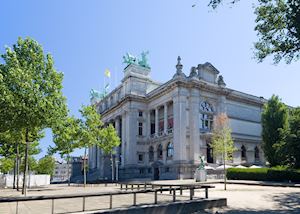 The southern, or Zuid, district of Antwerp was completely reconstructed following the demolition of the Antwerp Citadel in 1874. Today, you’ll find it’s a hub of art galleries and fashion boutiques, with Art Nouveau buildings lining wide boulevards, reminiscent of Paris. Most buildings were constructed in the late 19th century, including the Royal Museum of Fine Arts.
The southern, or Zuid, district of Antwerp was completely reconstructed following the demolition of the Antwerp Citadel in 1874. Today, you’ll find it’s a hub of art galleries and fashion boutiques, with Art Nouveau buildings lining wide boulevards, reminiscent of Paris. Most buildings were constructed in the late 19th century, including the Royal Museum of Fine Arts.
You can also see modern art collections at the Museum of Contemporary Art, with its sharp black-and-white-painted exterior housing a free permanent collection. The Photo Museum of Antwerp, or FOMU, features one of Europe’s foremost photo and photo equipment collections and showcases internationally known photographers in temporary exhibitions.
Best time to visit Antwerp
March to May and September to November are the best times to visit, as temperatures are comfortable and cultural events are in full swing, though the city feels busy. June through August has fewer visitors as many Europeans head to beaches instead. December is lively as the Christmas Market attracts people from all over the world. January and February are quiet, but many museums and attractions are closed.
who's been there
Start planning your tailor-made trip to Antwerp by contacting one of our Belgium specialists
-
617-223-4521617-223-4356
- Make an inquiry
Suggested itineraries featuring Antwerp
Our itineraries will give you suggestions for what is possible when you travel in Antwerp, and they showcase routes we know work particularly well. Treat them as inspiration, because your trip will be created uniquely by one of our specialists.
Photos of Antwerp
Accommodation choices for Antwerp
We've selected a range of accommodation options for when you visit Antwerp. Our choices usually come recommended for their character, facilities and service or location. Our specialists always aim to suggest properties that match your preferences.
-
![Hotel 't Sandt, Antwerp]()
Hotel 't Sandt
Antwerp -
![FRANQ, Antwerp]()
FRANQ
Antwerp
Ideas for experiencing Antwerp
Our specialists seek out authentic ways to get to know the places that could feature in your trip. These activities reflect some of the experiences they've most enjoyed while visiting Antwerp, and which use the best local guides.
-
Diamond District tour & diamond cutting workshop ![Loose diamonds, Antwerp]()
Diamond District tour & diamond cutting workshop
Diamond District tour & diamond cutting workshop
Explore Antwerp’s legendary Diamond Quarter, a stopover for 86% of the world’s legal raw diamonds, on this three-hour walking tour. Your guide will take you to a workshop where you can watch the gemstones be cut, shaped and polished.
View details -
Private canal cruise with champagne & charcuterie ![Banks of the Leie River, Ghent]()
Private canal cruise with champagne & charcuterie
Private canal cruise with champagne & charcuterie
See a world-renowned altarpiece, a bird’s-eye view of the city, a medieval castle and lively market squares on a walking tour of Ghent. Then explore the city’s waterways on a boat tour of the canals, where you’ll be served local delicacies and Belgian beer.
View details -
Bruges old town tour & canal cruise ![Canal cruise in Bruges, Belgium]()
Bruges old town tour & canal cruise
Bruges old town tour & canal cruise
Spend a few hours with a guide exploring Bruges’ historical highlights, where you’ll see artwork by Michelangelo, Gothic cathedrals and a towering belfry. Then, spend an hour cruising the postcard-worthy canals and see step-gabled houses and stone bridges.
View details -
Culinary walking tour of Antwerp ![Frites, waffles, chocolate and Belgian beer, Antwerp]()
Culinary walking tour of Antwerp
Culinary walking tour of Antwerp
Get to know Antwerp’s history and try some of its best cuisine on this guided walking tour. You’ll see the city’s oldest building and busiest square, and get to try frites, artisanal chocolates, waffles and beer.
View details
